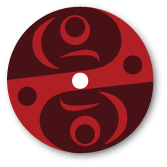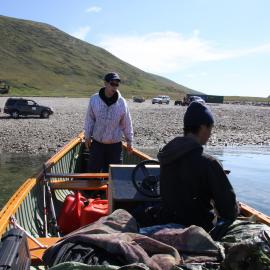Since 2011 I have worked with the Avataq Cultural Institute and have been a member of the IPinCH-supported case study “Cultural Tourism in Nunavik,” collaborating closely with project leader Daniel Gendron.
In this brief report, I describe the methods, achievements, and challenges associated with our case study.
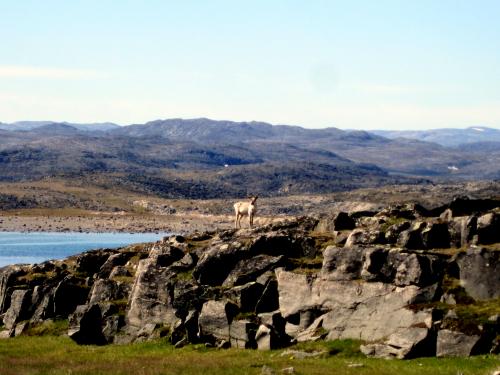
At very top, two young Inuit, Aipili Sakiagak (front) and his brother Putulik (back), getting ready to leave for Aivirtuuq, the location that Kangirsujuammiut want to develop for tourism. The brothers were part of the Cultural Tourism in Nunavik community-based initiative crew in 2010; above, Aivirtuuq (‘the place where there are walruses’) is located on a peninsula southeast of Kangirsujuaq. Aivirtuuq has many important sites, including two Dorset long houses and Saunitarlik (‘the river of bones’). All photos courtesy of D. Gendron, used with permission.
OVERVIEW AND CONTEXT
In 1981, the Elders Conference, an association of elders from 14 Nunavik communities, identified the mandate of the newly created Avataq Cultural Institute as being to protect and promote Inuit culture and language. Over the last 30 years, Avataq has been guided by this mandate, while also advocating for the development of cultural tourism in the region.
There seems to be a world of difference, however, between Avataq’s conception of responsible development and that driven by outside economic interests. Our study aims to identify the various parties that have a stake in tourism development in the region, along with their underlying motivations. What part do the Nunavimmiut—the Inuit people of this area—play in tourism development of the region? Are they silent participants or the driving force behind this endeavour?
One of the aims of our research is to promote cultural tourism that protects Inuit culture instead of selling it off. But there are political and other challenges, especially since tourism development must consider “Plan Nord,” the Québec government’s development scheme for the province’s northern region, which has a very different approach to economic opportunities and tourism. As the Québec Government currently presents this plan, local communities feel a pervasive sense of outsider invasion underlying this northern development. This is the context in which cultural tourism is currently taking place in Nunavik and in which this case study was conducted.
“What part do the Nunavimmiut—the Inuit people of this region—play in tourism development? Are they silent participants or the driving force behind this endeavour?”
The Nunavimmiut understand the need both to strengthen their identity and to develop a strong economic basis for this region. While these two objectives can go well together, there is a danger that the short-term effects of increased economic benefits will have a negative impact on cultural identity. Like other forms of development, cultural tourism may have such negative effects. The sudden increase in tourism development in the North—perceived as a short cut to economic success—made it clear that a study focusing on the fundamental reason behind this increased interest was needed.
In the past, all proposals for tourism development (excluding hunting and fishing ventures that are still important in some areas) emanated from non-Inuit parties that desired to bring visitors to discover the “real” north. For their part, the Government of Québec and the Kativik Regional Government (KRG) are in the process of developing several national parks in the Nunavik region. The first, Pingualuit, was officially launched a little more than three years ago; two more are in an advanced stage of development, and at least three others are in the preliminary study stages.
There are enormous expectations from this tourism development, but many questions remain about how such development will impact the culture of the Inuit. There is concern that this form of tourism may not align with the values of the Inuit of the region. Identifying Inuit perspectives on cultural tourism is one of the key objectives of our case study.
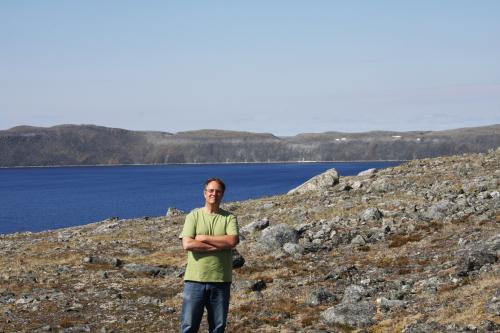
Project leader Daniel Gendron near Pingualuk, the crater lake supposed to be the main attraction of the Pingualuit National Park near Kangirsujuaq. Photo courtesy D. Gendron.
METHODS
Interviews were our primary means of data collection. To better understand perspectives on cultural tourism, we interviewed Inuit and non-Inuit individuals drawn from regional government, local organisations, and the Nunavik Tourism Association. Individuals not directly involved in tourism development and those hoping to work with tourism were also interviewed. The latter were identified once we arrived in the communities, through the radio or chance encounters in the village.
A strong sense of local identity has influenced the way tourism is perceived, and we wanted to ensure that this was represented in the study. The interviewing process was thus carried out in two phases. Phase I interviews took place in three northern communities (see map) and included individual and group participation. Phase II interviews were conducted in person in Montreal or by phone with workers in Québec City and Kuujjuaq where representatives of different organisations and government agencies were located.
A questionnaire was developed to gather information on the development of cultural tourism in Nunavik, and on the degree of involvement of local people. Such information would aid the Nunavimmiut in discussing and assessing the benefits of cultural tourism to their community.
RESEARCH PROCESS
Phase I of the study involved two weeks of fieldwork, carried out in July 2011. The villages of Kuujjuaq, Kangiqsualujuaq, and Kangiqsujuaq were visited. We conducted 16 formal interviews with community members, tourism actors, and local or government representatives, along with two discussions on FM radio stations in Kangiqsualujuaq and Kangiqsujuaq, and 11 informal interviews and discussions. Interviews were recorded and all discussions and observations were later transcribed.
Phase II of the study involved in-person and phone interviews with individuals from Montréal, Québec City, and Kuujjuaq. These interviewees were selected in regard to their position in the cultural tourism sector in Nunavik and in the province of Québec. A total of 14 interviews were conducted during this phase.
Interview data were analysed using a standardized approach. Key words and themes were underlined in the transcriptions and excerpts pertinent to our research objectives and questions were extracted. A first reading of the interviews was completed, with excerpts compiled by themes emerging from the text.
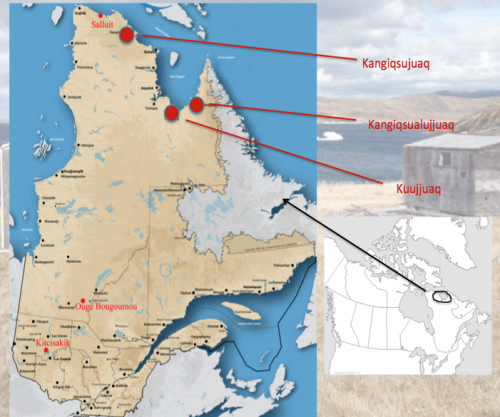
The region of Nunavik is located in the northern portion of the province of Québec. This map identifies the sites of the three communities involved in the Cultural Tourism in Nunavik case study (graphic E. Ruffin).
CHALLENGES IN COLLABORATION
One important lesson we learned is that summer is not an ideal time to conduct fieldwork of this nature in Nunavik. Many individuals are busy with hunting and fishing activities, and it is difficult to find translators. Initially, the trip to Nunavik was planned for spring, but delays in obtaining Avataq’s Ethic Board’s approval forced us to proceed with the interviews during the summer months.
We also now see how we can improve our collaborative research efforts by making it more proactive. It is impractical to exchange ideas and discuss documents using e-mails or phone calls with Nunavimmiut. While we would have liked to return to the communities with the preliminary report in order to obtain their comments, and to work on the final report, this was not feasible given our budget. It would have been ideal to organize more workshops at the beginning of our study to build the objectives and methodology, and to organize logistics; at the midway point to verify the first results and adapt the methodology; and at the end to present the results and to obtain comments and suggestions that would have improved the recommendations and the conclusion of the research. Some of this can still be done, but we will have to be more creative.
CONCLUSIONS
The final stage of the project will take place later this year. This will involve returning to the three partner communities to present our report and to obtain feedback on our results. The logistics of this remains to be determined.
We have planned a series of publications, including a brochure and posters. A formal cultural tourism proposal package, adapted to local interests, will also be developed with the aid of our community research partners. A written policy on cultural tourism still remains to be done, which will likely take the form of recommendations to be submitted to the relevant authorities in tourism development.
Our research is timely because it coincides with the start of the Plan Nord development scheme, which will be implemented over a 20- year-plus period. Our research will help the Inuit define some principal issues relating to this plan that may negatively affect their traditions and culture. It will also help them to determine how best to counteract these effects specifically in the context of cultural tourism.
There is no guarantee that the Québec Government will acknowledge the need for long-term preservation of Inuit culture in tourism development. Thus, it is important to involve the Inuit directly in defining tourism development to ensure the perpetuation of their cultural identity and traditions.
Émilie Ruffin is a Ph.D. Student at the Université Laval and an IPinCH Fellow.
This article was featured in the IPinCH Newsletter, Vol. 5 (Fall 2013).
